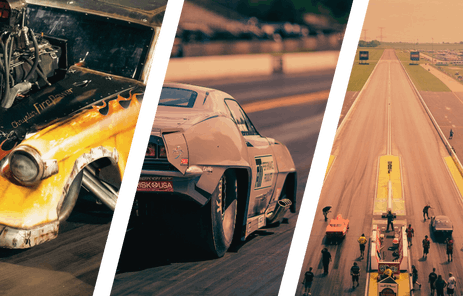Centrifugal superchargers use the engine’s crankshaft to spin, but they can use either a belt system or a gear drive to get the power they need from the crankshaft. Both systems have distinct advantages in high-performance applications, and with insight from our friends at ProCharger, we’ll explore which works best for different builds.
Belt and Gear Drive Systems Explained

There are three main drive setups for centrifugal superchargers: serpentine belt drives, cog belt drives, and gear drives. Each system interacts with the crankshaft differently and uses a unique mounting method. Let’s take a brief look at each before diving into their ideal applications.
A serpentine belt drive is the most common setup found on street-driven vehicles. As the name suggests, the centrifugal supercharger is spun using a serpentine belt that’s integrated into the accessory drive system via a crank pulley. A tensioner maintains proper belt tension as the blower spins and generates power.

A cog belt system is the heavy-duty version of the belt drive. Unlike the serpentine setup, it doesn’t spin accessories, just the crank pulley, a manual tensioner, and the supercharger. These robust systems are typically used on high-horsepower race applications.
When you need the most efficient way to generate serious power, a gear drive is the ultimate choice. ProCharger’s version, known as the CrankDrive, provides a direct link from the crankshaft to the supercharger through a gearbox mounted to the front of the engine, optimizing power transfer.

Serpentine Drive Belt Systems
The serpentine drive belt system is the most popular way to spin a centrifugal supercharger in a street or street/strip car. These kits let the vehicle retain all its creature comforts like air conditioning and power steering while adding a substantial bump in horsepower, often up to 300 horsepower on many engines.
This setup typically fits neatly inside the engine bay while leaving room for an intercooler and full-size radiator. One major advantage of serpentine systems is that they don’t require irreversible modifications during installation.

Modern engine technology has pushed horsepower levels even higher, so ProCharger has refined its serpentine systems with improved tensioners, additional idlers, and better belt wrapping for greater efficiency.
“With a serpentine system, the ceiling is going to be around 1,500 horsepower at the crank, about 1,200 to 1,300 horsepower to the tires. That’s with an upgrade to the wider eight- or ten-rib belt setup. When you start pushing past those levels, you really need to look at moving to a cog belt drive system,” says ProCharger’s Sergio Shifman.
Cog Belt Drive Systems
The cog belt drive system for centrifugal superchargers is designed for applications that need to make serious horsepower while still using a belt setup. These systems are simple, durable, and popular with racers who want to make over 1,500 horsepower without stepping up to a gear drive unit. Cog belt drives have been used for nearly 30 years and are easy to tune, just change the pulley to adjust supercharger RPM and boost (like a serpentine system).
Cog systems can work in street-driven vehicles, but be prepared for trade-offs. “The cog drive is going to be a lot more demanding on a vehicle that sees a lot of street use. They’re a little noisier for sure, and the belts are more expensive than a serpentine system. The solid-style belt tensioner also requires additional attention and maintenance,” explains Shifman.

These systems are ideal for vehicles making 1,500–2,200 horsepower. Top Sportsman and Top Dragster racers often use cog belt systems because they provide ample horsepower capacity, cost effectiveness, and flexible mounting options.
“We do have some Drag-and-Drive racers who use the cog belt system with their centrifugal supercharger. They can still run a full-size radiator with a cog drive since it doesn’t place the supercharger directly in front of the engine like a CrankDrive setup,” Shifman adds.
CrankDrive Supercharger Systems
At the top of the centrifugal supercharger drive system hierarchy is the CrankDrive. You don’t need to consider one unless you’re making more than 1,700 horsepower. The CrankDrive offers exceptional flexibility in power and boost levels. Quick-change gears inside the gearbox allow the user to adjust the blower’s RPM, making it easy to fine-tune power output.
The CrankDrive delivers unmatched durability and reliability for extreme horsepower applications. There are no belts to fail or misalign, and since it mounts the blower in a forward-facing position, it creates a ram-air effect for even more power. Changing boost levels is also cheaper. A gearset swap costs around $300, compared to about $450 for a belt and pulley change on a cog system.

“The CrankDrive is going to be the strongest option. It has crankshaft support and large billet mounts that prevent any flex. There’s no movement with everything being rigidly connected to the engine, so there’s no chance of slip at all,” says Shifman.
For dragsters with limited space, ProCharger also offers the RaceDrive, a compact, all-in-one gear drive and supercharger unit. This design moves the blower higher and closer to the engine, allowing it to fit behind the driver in shorter chassis configurations.
Conclusion
Different builds have different requirements, which is why multiple drive systems exist for centrifugal superchargers. Serpentine belt drives, cog belt drives, and gear drives all have their place in high-performance applications. Understanding how each works will help you choose the right system for your build and make sure every bit of horsepower reaches the pavement.
You might also like
Good Time Charlie: How Parker Cannon’s 1965 GTO Became Powerhouse Street Car
Charlie Parker's 1965 GTO is a real street beast. This build is the result of Parker's obsession with cars and creating memories.



